Kaisika Natakam
The
temple at Thirukurungudi, in the Tirunelveli district in southern Tamilnadu
is a sacred center rich in history and legend. A massive structure in the
heart of a cluster of small villages, this Vishnu temple is home to an
array of stunning sculptures and workmanship of the 12th century Nayak
rulers.
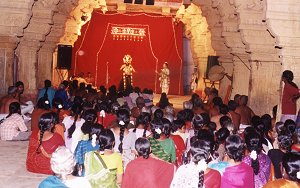
Thirukurungudi
is also the only sacred site for the annual ritual called kaisiki natakam.
This is an all-night drama and dance performance laced with the story of
a demon who demands the life of a devotee preparing to offer prayers to
the Lord on this special night which falls in the lunar month of Kaisiki
(mid-November/early December). The ensuing debate and the actual ritual,
saturated with eloquent poetry in old Tamil, snatches of humour and dance
attracted thousands to this shrine in the belief that it was a special
blessing to remain awake all night in the presence of Lord Vishnu and witness
this tale.
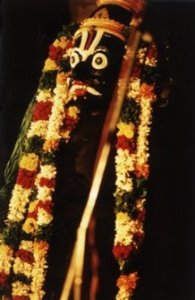
Alongside
the revival of classical and folk arts in India during this century some
of the obscure ritual arts had slowly drifted to atrophy. Traditional communities
of dancers and musicians had fallen into disfavour with the elite and with
them invaluable repertoire and literature of ritual-performances like kaisiki
natakam.
Arangham has
taken the responsibility of reviving this 10th century performance-art,
unique to this temple, establishing an on-going support for the four remaining
artistes, helping them to recollect and remember the text, movements and
music of the kaisiki natakam. The responsibility extends far beyond the
actual performance to social and cultural activism. Rekindling confidence
in these artistes who are all between the ages of 65 and 80, renewing respect
with the local townsfolk for this exquisite tradition and developing a
new cluster of artistes who can study this ritual-art and perform it annually
at Thirukurungudi at festival time is our multi-prolonged aim.
Latest Developments

Considerable
progress has been made since April 1998 in re-establishing the text, recording
the music and recapturing some of the original dramatic narrative and movements.
Aided by renowned Tamil theatre directors N. Muthuswamy and Professor Ramanujam,
the first phase of the revival performance of kaisiki natakam was held
in December 1999 after a gap of 43 years. There was an unprecedented response
to the performance with a crowd of over a thousand staying up all night
to partake in the revived moments!
The second
performance of kaisikinatakam was held on December 7, 2000 and this time
too the response was overwhelming. The costumes were more elaborately designed,
the movement stucture was re-defined and more characters were included
too. The five, ageing, traditional performers, shared the stage with a
younger group of 15 actors, dancers and musicians. The performance lasted
for 41/2 hours, beginning at 10pm and concluding at 2.30am.
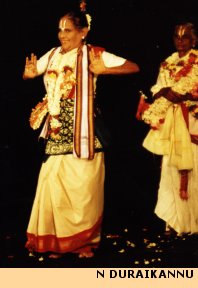
The
renewed interest in the performance ritual has spurred the artistes to
further research and exhilirating performances in November 2001 and December
2002.
A bereavement
that hit the Kaisiki Natakam project was in the demise of N DURAIKANNU,
the 89 year old doyen of the dance tradition, in February 2003. On August
9, 2003, the Kaisiki Natakam artistes met at Vadoor Temple (near Thanjavur)
and commemorated her memory by performing two scenes from the Kaisiki Natakam
in the temple premises. Her daughter, son-in-law and other members of the
family, continue the fine tradition.
The research
and recording has been made possible due to the continued support and encouragement
from members of the international Bhakti List as well as patronage from
the TVS business group since the Thirukurungudi village is the native home
town of the company's founder, Sri T V Sundaram Iyengar.
The Reconstruction
Process: Important Details
Some important
details about the reconstruction and revival of the Kaisiki Natakam:
The traditional
raga or pann called Kaisika or Kausika is the predominant raga in this
ritual play. According to musicologists like Vaithialingam, many other
raga-s like Malahari, Gandharam, Nata, Dhanyasi and Vasanta, were also
utilised in the play.
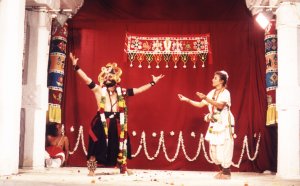
The
original palm-leaf script of the Kaisiki Natakam was written by Veerabhadra
Nattuvanar in the 13th century.
There are 40
paasuram-s on the Tirukurugudi Nambi perumal in the Divya Prabandham. Tirukurungudi
was at one time under the control of the Travancore royal family. After
the formation of the Madras Presidency, the court's hold over the temple
weakened but Namboodri priests continued to conduct worship at the temple.
The research
and reconstruction efforts are concentrated in Tanjavur at the Bhavupillai
Natya school whose director Herambanathan is a traditional natyacharya.
His mother-in-law, Doraikannu, alias Revathy, is also an integral part
of the process. She is making an invaluable contribution with her experience
and cultural memory of the ritual dance in temples.
Traditional
dancers are too old, weak and unable to remember anything substantial on
which to base the reconstruction. In the circumstances, only Bharatanatyam
and Bhagavata Mela traditions have been used as starting points of movement
and abhinaya explorations. The purpose is not to superimpose one or both
styles on Kaisiki Natakam but use them as springboards for free expression.
After seeing
the first revival performance of the Kaisiki Natakam on 19th November 1999,
elderly residents of the Tirukurungudi have made valuable inputs. Several
women have come forward and offered their earlier memories of how the actors
would move or speak, their tone and their mannerisms. All the suggestions
have been recorded and noted for implementation in Phase II of the project.
Kaisiki
Natakam - A report on a revival project
by Anita Ratnam
(courtesy SRUTI, Issue 190, July 2000)
Kaisiki
Natakam, a heart warming and intensely human tale, has gripped the imagination
of commoners and kings down the centuries. After a long hiatus, it was
revived with a performance on 19th November 1999.
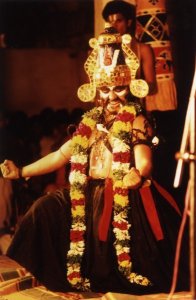
In
the Varaha Puranam, Lord Vishnu tells the story to Mahalakshmi about how
he adores being worshipped through dance and music. Kaisiki Natakam, which
is traced back to the 13th Century, tells the story of a lowborn “Chandala”
called Nambaaduvan who devotes one night every year, on Kaisiki Ekadasi,
to singing the praises of Nambi Perumal. On that day one year, he was travelling
to the temple when a Rakshasa (demon) stops him and demands his flesh.
After great persuasion, Nambaaduvan tells the Rakshasa that he would return
to be eaten by him after completing his annual offering of music to Nambi
Perumal. Convinced of the Chandala's sincerity, the Rakshasa allows him
to proceed to the temple. After singing all night in front of the Lord,
Nambaaduvan is in his way to the Rakshasa to fulfill his promise. At that
time, Lord Vishnu himself, in the guise of an old man, stops him and asks
him to take another route, warning him of a dangerous Rakshasa who eats
all in his path. Nambaaduvan refuses to break his promise and proceeds
to meet his death. When the Rakshasa meets him again, his mood has changed.
He now demands that Nambaaduvan give over to him not his physical body
but the Punyam (Fruits of good deeds) he has acquired from his musical
offerings to Nambi Perumal. Nambaaduvan refuses and then is told that the
Rakshasa is really a Brahmin who has attracted a curse because of his arrogance
and who would be redeemed from the curse by a chandala.
The story has
an unusual element in that it points to the special place music and dance
has in religious worship in temple societies of ancient times. The divisions
of caste and class were blurred when it came to the purity of a devotee's
intent. Similar to the practice connected with Vaikunta Ekadasi, devotees
would fast and stay awake during the night of the Kaiski Ekadasi and listen
to music and dance in praise of Nambi Perumal (the name given to Lord Vishnu
in Thirukurungudi in Tirunelveli district of Tamil Nadu). This was an act
of great piety.
Early in 1996,
Na. Muthuswami, well known Tamil theatre activist and Director of Koothu-p-Pattarai,
came to see me with Prof. S Ramanujam of Tanjavur, respected theatre director
and consultant. The two of them informed me about this one valuable ritual
tradition which had completely declined at the temple in Tirukurungudi
which is my native place.
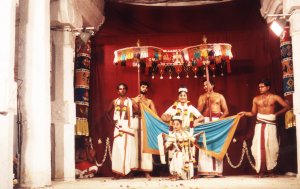
Kaisiki
Natakam was performed in Tirukurungudi with great fanfare upto 1955. Due
to scholars, as well as patrons like the late T.V. Sundaram Iyengar, thousands
of devotees used to throng the massive temple in Tirukurungudi on the night
of Kaisiki Ekadasi every year. After the demise of Sundaram Iyengar in
1955, the play, which used to extend for five hours past midnight, seemed
to have lost its appeal, content and audience. I witnessed a performance
for the first time in 1996. It was very poorly attended and, worse, poorly
performed. All the performers were weak, aged, and had completely forgotten
their roles.
It is then
that I decided to take up a project to revive and revitalize the Kaisiki
Natakam tradition. When the project was first begun in June 1996, the tradition
was almost extinct. Five artists whose family had performed this ritual
play annually at Tirukurungudi were old, feeble and had forgotten almost
all the words and movements. More over the script for the play was not
available. In the event, it had to be traced from various sources. The
first part was received from Tirunarayanan, Manager of the temple. The
other part was traced to Narayanan Kambar, the artist who had performed
the role of the nattuvanar who lived now in Nanguneri, a neighbouring village.
A palm leaf manuscript of the natakam was subsequently found at the Jeeyar's
mutt in Tirukurungudi itself.
After tracing
the entire text, we began the reconstruction of the music. This step by
step process required the composition of few songs and some verses in Carnatic
ragas, based on the rules of ancient Tamil songs. Well known vaishanavite
scholar Dr. Venkatakrisnan's audio cassettes rendition of the Kaisiki Natakam
was used as a reference guide during the long dialogues between the Brahma
Rakshasa and the devotee Nambaaduvan.
But all this
was not enough. Since there were very few traces of the script, music,
movement, and style, we had to undertake a complete re-creation of the
play. Prof. Ramanujam had extensive discussions with musicologist in Chennai,
natyacharya Herambanathan of Tanjavur and musician of the Mellatur Baghavatha
Mela. Out of these discussion emerged a framework. Herambanathan identified
some musicians and dancers from Thanjavur who, in the event became the
first core group to learn the music and movement of the re-constructed
Kaisiki Natakam. All the performers were given a background briefing and
an orientation course on Kaisiki Natakam. Vinod, a college student who
performs in the Bhagavata mela Natakams was asked to do the role of the
Brahma Rakshasa. All the new artists who are based in Tanjavur were taken
to Tirukurungudi to meet the traditional performers of Kaisiki Natakam
at the Nambi temple. This visit made a great impact on both the groups.
Many new discoveries about the dance, music and dialogue were made during
casual conversations with the traditional artists and the local residents.
Later, we also included Dorai Amma, a very well known Devadasi of Tanjavur
and one of the original performers in the Sarabendra Bhoopala Kuravanji,
in the revival project.
A prototype
of the reconstructed Kaisiki Natakam was revealed to a group of writers,
theatre directors, musicians and dramateurs from Chennai, Tanjavur and
Madurai on 15th September 1999 at the Venkatesa Perumal Sannidhi in Tanjavur.
It was accepted by everyone and it was agreed that the artists would work
towards a full-length performance in Tirukurungudi on Kaisiki Ekadasi on
19 November 1999. On Kaisiki Ekadasi day a very large crowd gathered at
the Tirukurungudi temple. Before the commencement of the Kaisiki Natakam,
I performed a special dance programme called Natya Aradhana. The dance,
the text of which consisted of ten paasurams hymns about Tirukurungudi
selected from the Divyaprabandam, was dedicated to Nambi Perumal. Hundreds
of school children from the neighbouring towns attended the performance
between 8 and 9 pm.
Kaisiki Natakam
began at 9.30 pm, after this dance, with 22 actors and musicians from Thanjavur
sharing the stage with five traditional Tirukurungudi performers. All five
of the traditional Tirukurungudi performers performed although one of them
came to the stage briefly due to weakness and old age. She was 84 year
old Ramanuji Ammal who used to take the role of Nambi Perumal disguised
as the old man. Her artistic colleague also belonging to the Isai Velalar
community Kurungudi Amma aged 77, was a once celebrated performer who had
even danced as temple idols where taken around in processions. Even today
some residents of Tirukurungudi recall her dazzling prowess in dance and
music.
The large crowd
of 3000 persons witnessed a historic re-enactment of Kaisiki Natakam, which
lasted for 3 hours and 15 minutes. Virtually all were moved to tears by
the excellent performance of all the artists - and especially those of
Vinod as Rakshasa and Muthulakshmi as Nambaaduvan. While the first phase
of the project to re-construct and revive the Kaisiki Natakam was thus
successfully completed its revitalization is still in progress.
For this purpose,
video and photo documentation of the performance has been done. A microfilm
version is being prepared by the Saraswathi Mahal Library in Thanjavur.
Work is now underway to strengthen the music and movement portions of the
performance. Specialists in each area are being enlisted to work with the
artists and the musicians to reconstruct the entire five hour ritual drama.
|